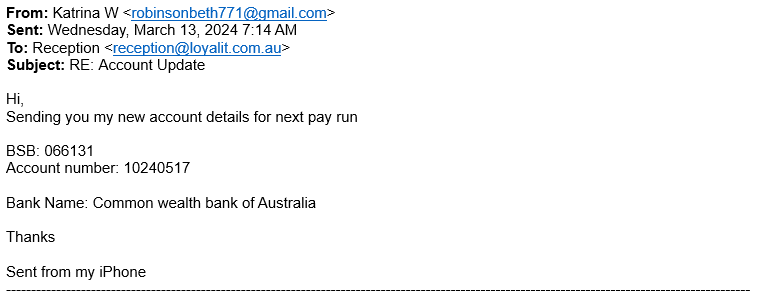Phishing Emails

What is Phishing?
Phishing is a social engineering technique to acquire data, such as bank account details, login credentials or credit card numbers. It occurs when an attacker, masquerading as a trusted entity, dupes a victim into opening an email, an instant message, or a text message.
How to recognise Phishing
If scammers get that information, they could get access to your email, bank, or other accounts. They could sell your information to other scammers. Scammers launch thousands of phishing attacks like these on a daily basis — and they’re often successful.
Phishing emails or text messages often tell a story to trick you into clicking on a link or opening an attachment. You might get an unexpected email or text message that looks like it’s from a company or an individual that you know or trust. Or maybe it’s from an online payment website or app. The message could be from a scammer, who might say they’ve noticed some suspicious activity or log-in attempts — they haven’t. Say you need to confirm some personal or financial information — you don’t. Include an invoice you don’t recognize, or one you might recognise but with their fake bank account details included — it’s fake. They might ask you to click on a link to make a payment — but the link has malware. They might say you’re eligible to register for a government refund — it’s a scam!
A Phishing email could look something like this:
Just imagine you received an email like this in your inbox. At first glance the email looks real.
But it’s not. Scammers rely on you being too busy to take more than a quick glance before responding.
Signs that this email is a scam;
Even though it might look like it comes from a person or a company you know (it may even have the company logo on the email):
· the email has a generic greeting
· there is no name in the sign off
· the bank name is not correctly typed
· the sender's email address has no reference to the Senders name
While real people or companies will communicate with you by email, you likely know their email address.
Always check the sender's email address before clicking send on your reply (yellow highlight)
Your email spam filters, like MailGuard, will keep most phishing emails out of your inbox.
Scammers however, are always trying to outsmart spam filters.
Here are four suggestions you can implement to avoid phishing attacks.
1. Protect your computer by using security software
2. Protect your mobile device by setting software to update automatically
3. Protect all your accounts by setting up multi-factor authentication
4. Protect your data by backing it up
One last recommendation is for you or a member of your team to enrol in The Cyber Wardens Programme.
This is an online short course funded by the Australian Government to protect small businesses from the onslaught of online threats.
- It is free
- Can be completed in 45 minutes
Be a CYBER WARDEN TODAY
If you have any questions or concerns please get in touch with Loyal IT Solutions. Our friendly Technicians are here to help. 02 4337 0700 or reception@loyalit.com.au
| Tags:ITCyber SecurityEmail |







